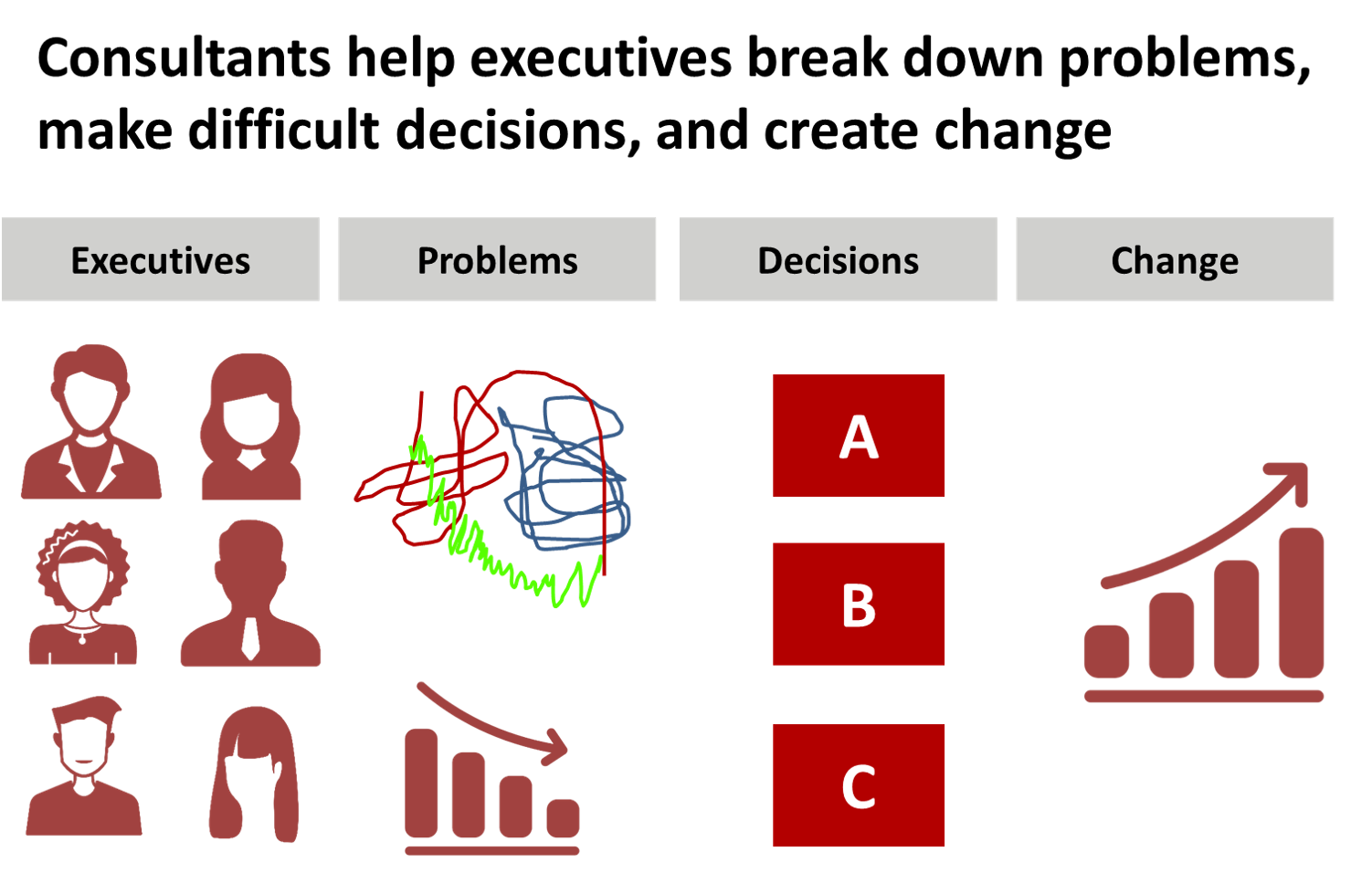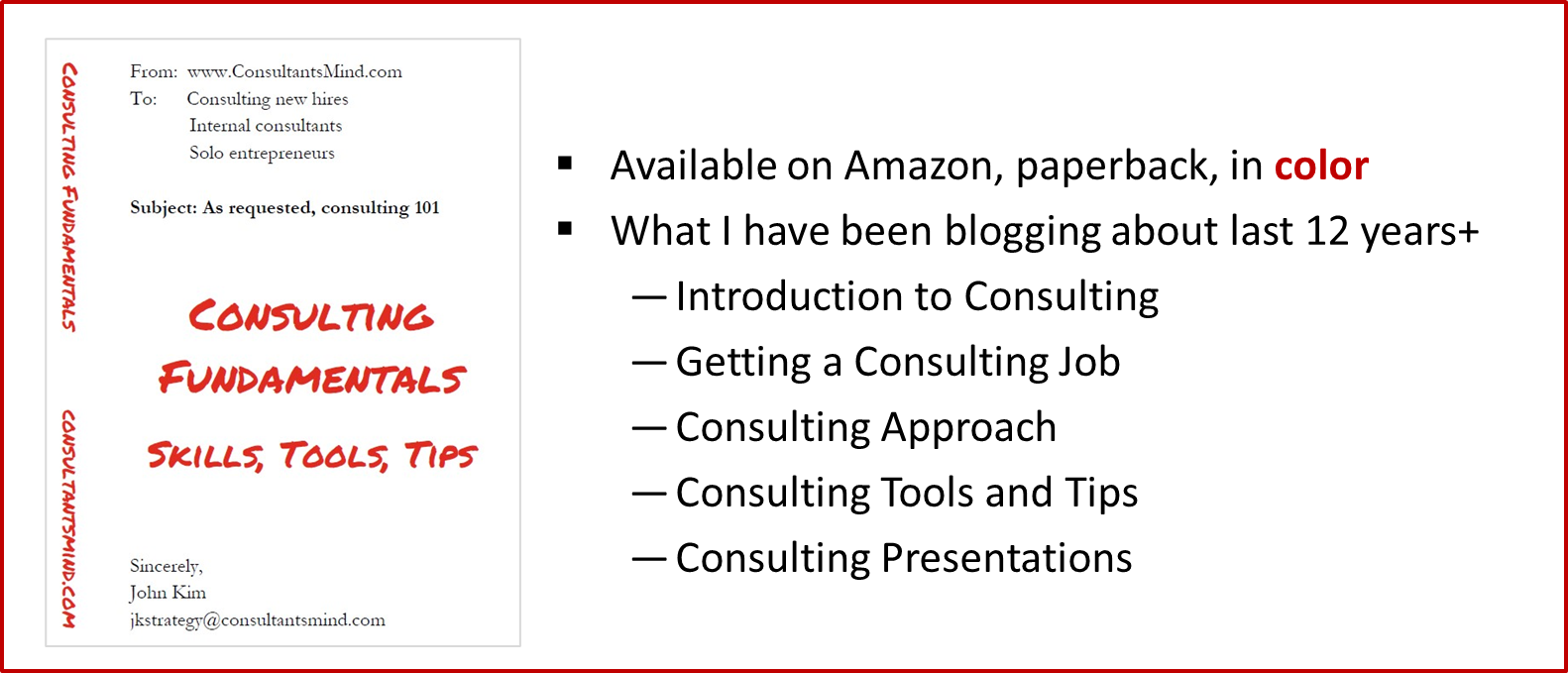Consultants break down problems
Open up any newspaper and you see that problems abound. Problems vary from the specific (e.g., corporate concerns about market share) to the global (e.g., accelerating climate change). Yes, to some this may seem negative and a bummer. To the ambitious management consultant, this looks like opportunity.
Recall, we are in the business of helping executives, break down problems, make difficult decisions, and create change. Let’s talk about the 2nd part (breaking down problems).

What kind of problems?
If you join a generalist consulting firm, you will be surprised by the diversity of work. It will likely vary:
- By industry – telecommunications, mining, retail, transportation, financial services
- By client – broad-line incumbent, vertically integrated incumbent, niche new entrant
- By function – sales, marketing, manufacturing, operations, pricing, human capital, IT
- By geography / business unit – just North America, or European, or global?
- By duration – everything from a 3 week due diligence to a 6 month implementation
- By purpose – customer loyalty, growth, cost reduction, forward integration, carve-out
Every project is different
Yes, the elements are different. Yes, the business cycle is different. Yes, your role (analytics, client interaction) can be different. Are you a finder, minder, or grinder? So it starts looking like a multi-dimensional cube.

Where to start?
For the newly hired, this is exciting and also a bit disorienting. The questions start to fly:
- Where is the start, middle, end of this problem?
- What’s within scope?
- How can I possibly be competent with a room full of people with more experience?
1) Follow the consulting process
I mentioned this just yesterday to a consulting team. Once you have a proposal and a statement of work (SoW) you have some initial ideas on how to “problem through” the solution. You have hypotheses. You have client interactions. You have some initial industry, competitive research. Namely, you know some things. Don’t freak out.
2) Work backwards from the goal
Consultants need to be smart and quick with their work. The clients are not paying us to hang around. Nope, if the client are savvy (and most are), then they have only given you (just) enough time to do the job. So, with the time constraints, always remember the purpose of the project:
- What does great look like?
- Who is the decision maker?
- What would phase 2 (or the implementation) be? What are the potential risks and scenarios?
- What is the commander’s intent?
3) Open up the problem slowly
Yep, I said it. Go slow at first. No matter how short your project timeline, don’t rush. Be thoughtful. Open the problem up and look around. Make sure you are solving the right problem.
- What has been the obstacle so far?
- Are there false assumptions we’ve been operating on?
- Who are the stakeholders that need to be involved (who haven’t in the past)?
- Are the client’s metrics really measuring the right things?
Early in the project, make sure that you go broad enough to see the edges of the full problem. For example, the client might have an inventory problem for many potential reasons:
- Bad forecasting of demand (not enough of the right stuff in the right place)
- Inefficient transportation and warehousing (inventory broken, partially shipped, or in the wrong place)
- Terrible product design (leading to poor sale)
- Low quality manufacturing (creating scrap, rework, and delays)
- Inefficient pricing (overshooting customers’ willingness-to-pay, or underpricing)
4) Listen (and don’t Listen) to the client
Don’t assume that clients can self-diagnosis their own problems perfectly. Think of this like a doctor / patient relationship. How often do you think that patients misinterpret their illness? I imagine . . .a LOT.
Remember, consultants make their money by asking good questions. This is doubly true during the problem identification phase. Consultants have the benefit of having seen a largely sample size (industries, clients, business cycle) and have more objectivity because they are external to the organization.
“We can’t solve problems by using the same kind of thinking we used when we created them.” – Albert Einstein
5) Use frameworks to find the key drivers
All business problems have some similarities. There is a bevy of different approaches, tools, frameworks to help you simplify complex problems into their key drivers. Just a few that immediately come to mind:
- DMAIC: for process improvement, define / measure / analyze / improve / control the process
- RACI: who’s responsible / accountable / consulted / informed of the work
- SIPOC: who suppliers / inputs / to the process / to create outputs / for the customer
- CTQ: what is critical to quality, and what is a little superfluous
- Fishbone / Ishikawa diagrams: what are the root cause, drivers of this problem
- Profitability: do we have revenue problem (price, quantity, mix) or a cost problem (COGS, SG&A)
6) Use management tools
Bain & Company has interviewed executives since 1993, asking them two fundamental questions:
- What management tools do they use most frequently?
- How satisfied have they been with them?
For those who want to see some of the big buckets of problem solving, this is hugely useful. Of course, there is a LOT of room for interpretation. Of course, “pricing” or “mergers and acquisitions” or “advanced analytics” is too broad to solve a client’s specific challenge, but it provides a LOT of value and the broad parameters to do the work. Trust me, this is worth hundreds of dollars in my opinion – and it’s free:
Bain & Company’s most recent study from 2018 here (16pg) with descriptions of the tools here (68 pg).
7) Put things in “buckets”
Consultants love buckets and you should too. Read more here.
Q: Is “bucket” a verb? A: Yes.
Q: Can most consultants tell you what the buckets of their project is? A: Yes.
Q: Is sorting chaos into sensible groups (buckets) a core consulting skill? A: Yes.
8) Refine your hypotheses
Consulting is guessing your way to the answers. It’s not perfect from day one. We do the research and have a point of view, but this evolves over time. We get more information. We get feedback from clients. We are proved wrong by the analysis (it’s okay for hypotheses to not be right). We arrive at an acceptable solution set.
This is the dark art of consulting. We get better at hypotheses over time because we have:
- A larger sample size of clients, projects, experiences to draw from
- A better understanding of client’s needs vs. wants
- Realistic expectations of what can happen during the project vs. phase 2 implementation
- Learn from others; this is entirely an apprenticeship
- Our point of view changes to match the business environment; it’s okay to change your mind
9) Divide up the work
Consulting is not a one person adventure. It is built on a leverage model where people of different level, talents, experience, and bill rates, do different tasks. It’s a sweet chamber quartet, people playing their own instruments, but also coming back together harmoniously.
10) Share your thinking with clients
Consultants are collaborative. We are hired to make our clients successful, which of course means involving them in the process. We don’t do consulting TO them, we do consulting WITH them. Remember, many of our clients’ challenges are cross-functional, and it means getting a LOT of different, diverse stakeholders on board.
The best ideas are vetted by the client and become their ideas. Ideally, your client counterpart will present the recommendations to their boss (or the Board of Directors) as if they were their own. Mind meld.


What a wealth of information and resources! Thanks, John!
Great framework. Helps me to build my mindset
This is well understood, well loaded with wonderful information to build on
Thanks, John!
Really Great information and framework.
Helps me to improve my knowledge in consulting approach.
Winning,
Great information! Thank you!